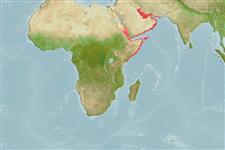Common names from other countries
Environment: milieu / climate zone / depth range / distribution range
Ecologia
marinhas demersal; intervalo de profundidade 20 - 50 m (Ref. 28016). Tropical; 30°N - 2°S, 32°E - 62°E
Western Indian Ocean: Persian Gulf (Ref. 3467) to the Red Sea and immigrated via the Suez Canal to the Mediterranean Sea (Ref. 11441).
Tamanho / Peso / Idade
Maturity: Lm ? range ? - ? cm
Max length : 25.0 cm TL macho/indeterminado; (Ref. 30573)
Descrição suscinta
Chaves de identificação | Morfologia | Morfometria
Espinhos dorsais (total) : 1; Raios dorsais (total) : 30 - 33; Raios anais : 30 - 33.
Lives in coastal rocky substrate, usually with vegetation. Consumes small invertebrates plucked from rocks (Ref. 52629). One of the earlier Lessepsian immigrants actually well
established in the eastern part of the Mediterranean Sea and it inhabits various substrates and is usually encountered on rocky bottoms with vegetation, sandy and muddy bottoms as well as seagrass meadows (Ref. 104758).
Ciclo de vida ou comportamento de acasalamento
Maturities | Reprodução | Spawnings | Egg(s) | Fecundities | Larvas
Hutchins, J.B., 1984. Monacanthidae. In W. Fischer and G. Bianchi (eds.) FAO species identification sheets for fishery purposes. Western Indian Ocean (Fishing Area 51). Vol. 3. FAO, Rome. pag. var. (Ref. 3467)
Status na Lista Vermelha da UICN (Ref. 130435)
CITES (Ref. 128078)
Not Evaluated
Ameaça para os humanos
Harmless
Uso pelos humanos
Pescarias: pouco comercial
Ferramentas
Relatórios especiais
Baixar XML
Fontes da internet
Estimates based on models
Preferred temperature (Ref.
115969): 23.5 - 29.2, mean 26.1 (based on 42 cells).
Índice de diversidade filogenética (Ref.
82804): PD
50 = 0.5312 [Uniqueness, from 0.5 = low to 2.0 = high].
Bayesian length-weight: a=0.01738 (0.01425 - 0.02120), b=2.92 (2.86 - 2.98), in cm Total Length, based on LWR estimates for this species (Ref.
93245).
Nível Trófico (Ref.
69278): 4.6 ±0.09 se; based on food items.
Resiliência (Ref.
120179): médio(a), tempo mínimo de duplicação da população 1,4 - 4,4 anos (Preliminary K or Fecundity.).
Fishing Vulnerability (Ref.
59153): Low vulnerability (15 of 100).
